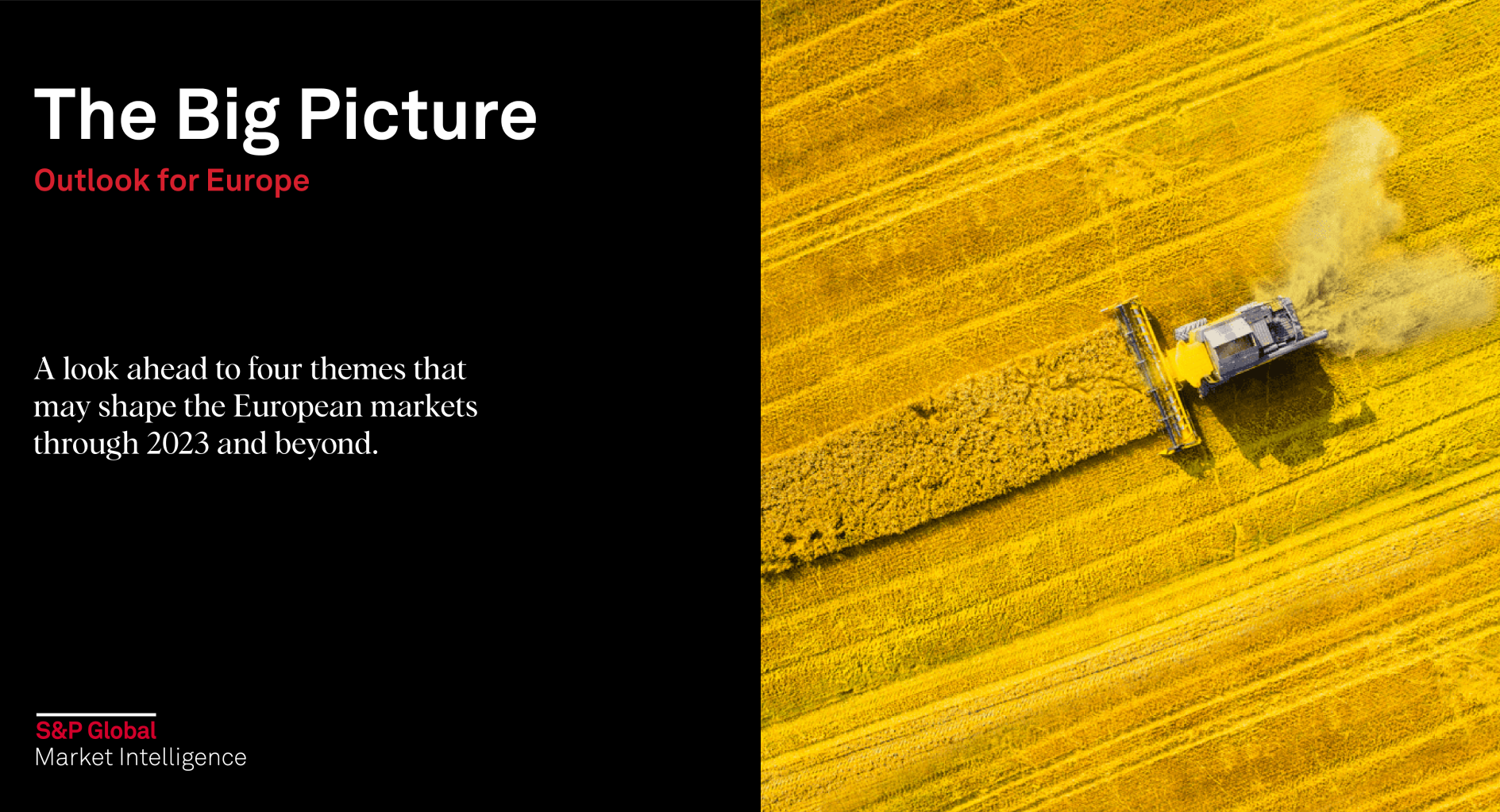
Soaring inflation and the Russia-Ukraine war were key European disruptors in 2022 and are risk factors closely tracked in our 2023 Big Picture Outlook reports. What other risks will impact your decisions in 2023? We review four themes that may shape the European markets in the year ahead.
The Big Picture Outlook: Four Predictions for Europe in 2023.
Download the Full Report here.Economics & Country Risk: Russia’s regional ambitions represent a longstanding open test
Russia’s invasion of Ukraine dashed all optimism of a smooth recovery following the COVID-19 pandemic. Instead, the year brought commodity price runs, historic inflation rates, monetary tightening, more supply chain disruptions, a refugee crisis at the center of Europe, and renewed worries around energy security.
Entering 2023 much depends on the severity of the European winter, on likely further sanctions, and on prospects for global measures being considered to cap the price of Russian oil. Economic and energy security concerns will drive short-term mitigation strategies in Europe, increasing fiscal, social, and political challenges for governments - especially those facing scheduled elections in 2023.
Tightening financial conditions will lead to a further slowdown in global economic growth, putting expansions in vulnerable regions at risk and deepening anticipated recessions in Europe. We expect the combination of subpar economic growth, rising unemployment, and improving supply chain conditions to eventually cause inflation to subside over the next two years.
Global Trade: Changes in trade caused by Russia-Ukraine conflict
The Russia-Ukraine war has disrupted global markets for fossil resources, including gas and coal. If the war in Ukraine becomes more prolonged, the relocation of supply chains may lead to a new structure of the world economy. In such a scenario, Russia would find it difficult to regain its economic position before the conflict.
Meanwhile, Russia ranked among the top 10 gas exporters and the main gas suppliers to Europe, with EU countries importing about 50% of their gas from Russia. Replacing Russian gas with LNG is difficult due to infrastructure shortages. The largest number of LNG terminals are in markets importing small amounts of Russian gas (France, Spain, Portugal), and the fewest in Central and Eastern Europe (only in Poland, Croatia, and Lithuania). The lack of unanimous support for the embargo on Russian gas by EU countries prompted the European Commission to postpone actions to reduce dependence on Russia. Concurrently, Russian leader Vladimir Putin has tried to prove that he does not need the European market by finding powerful allies in other regions of the world. In the first nine months of 2022, Gazprom increased gas supplies to China via the Power of Siberia gas pipeline by 61%, according to Interfax. Moreover, the European Council has decided that the EU will stop importing almost 90% of its crude oil from Russia by the end of 2022. The temporary derogation will apply to oil delivered via pipelines.
Despite the embargo imposed by the European Union on the export of goods to Russia, there has recently been an increase in exports of goods from Russia to Kyrgyzstan and from Kyrgyzstan to Russia, further demonstrating Russia’s range of options for lessening the impact of EU economic sanctions. Global supply chains are adapting quickly to the economic disruptions caused by war in Eastern Europe. Relocations of Russia’s trade in raw materials show the high heterogeneity of supply chains, yet the conflict may lead to permanent shifts.
Mergers and Acquisitions: Private equity firms expected to become more active
Overall M&A activity plummeted in 2022. Private equity firms — a major driver behind M&A activity — slowed their purchasing activity as interest rates jumped and increased the cost of the leveraged financing that financial sponsors often use. However, we expect private equity firms to become more active and take advantage of market opportunities that develop in the year ahead. For instance, Europe is facing energy constraints due to the war in Ukraine and sanctions against Russia, and private equity firms have already ramped up investments in the continent’s traditional and renewable energy companies.
Issuer & Investor Relations: ESG and climate related financial risk management increasing in importance
Speaking in capital market terms, 2022 was a very active and volatile year. ESG and the management of climate-related financial risks experienced a massive push and rise in terms of importance from both issuers and capital markets participants. Even though global sentiment varies by region, the direction has been mutually agreed by the market. This year brought different accelerators, such as the European Regulations of the Sustainability Taxonomy and the Sustainable Finance Disclosure Regulation, which went live. And many others are anticipated in the coming years. The U.K. introduced mandatory Task Force on Climate-Related Financial Disclosures (TCFD) rules for major market players and Switzerland is expected to do the same soon – just to mention a few. And finally geopolitical forces such as the war in Ukraine and the aftermath of COVID-19 accelerated the sensitivity of supply chain risks.
All these different forces have been anticipated by large institutional investors who are starting to deal with this kind of information either by integrating it in the risk management and valuation models or by rejecting and fighting against the new standards. Both reactions heighten the topic’s importance.
For further insights, download all the 2023 Big Picture Outlook reports HERE.



